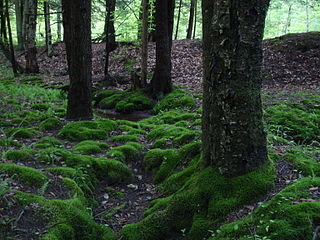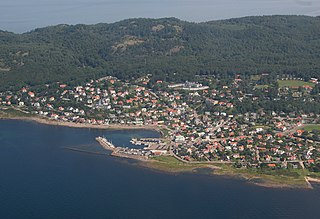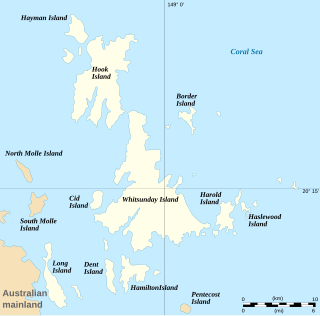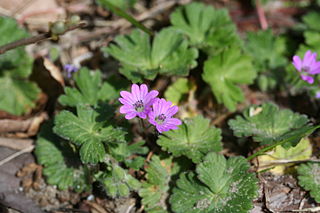
Molle Islands is a national park in North Queensland, Australia, 913 km northwest of Brisbane. The park covers several continental islands a short distance offshore including Long Island, Tancred Island, Repair Island, Planton Island, Goat Island, Denman Island and the majority of North Molle Island, Mid Molle Island and South Molle Island. The park features white sandy beaches, open eucalypt forests, rainforest-clad gullies and grasslands. The traditional owners of the islands were the Ngaro people.

Mosses are small, non-vascular flowerless plants in the taxonomic division Bryophytasensu stricto. Bryophyta may also refer to the parent group bryophytes, which comprise liverworts, mosses, and hornworts. Mosses typically form dense green clumps or mats, often in damp or shady locations. The individual plants are usually composed of simple leaves that are generally only one cell thick, attached to a stem that may be branched or unbranched and has only a limited role in conducting water and nutrients. Although some species have conducting tissues, these are generally poorly developed and structurally different from similar tissue found in vascular plants. Mosses do not have seeds and after fertilisation develop sporophytes with unbranched stalks topped with single capsules containing spores. They are typically 0.2–10 cm (0.1–3.9 in) tall, though some species are much larger. Dawsonia, the tallest moss in the world, can grow to 50 cm (20 in) in height. There are approximately 12,000 species.

Sphagnum is a genus of approximately 380 accepted species of mosses, commonly known as sphagnum moss, also bog moss and quacker moss. Accumulations of Sphagnum can store water, since both living and dead plants can hold large quantities of water inside their cells; plants may hold 16 to 26 times as much water as their dry weight, depending on the species. The empty cells help retain water in drier conditions.

MOLLE is an acronym for Modular Lightweight Load-carrying Equipment. It is used to define the current generation of load-bearing equipment and backpacks used by a number of NATO armed forces, especially the British Army and the United States Army.

Mölle is a locality situated in Höganäs Municipality, Skåne County, Sweden with 715 inhabitants in 2010.

The Whitsunday Islands are 74 continental islands of various sizes off the central coast of Queensland, Australia, 900 kilometres north of Brisbane. The northernmost of the islands are off the coast by the town of Bowen, while the southernmost islands are off the coast by Proserpine. The island group is centred on Whitsunday Island, while the commercial centre is Hamilton Island. The traditional owners of the area are the Ngaro people and the Gia people, whose Juru people has the only legally recognised native title in the Whitsunday Region.

The Dalle Molle Institute for Artificial Intelligence Research is a research institution based in Lugano, in Canton Ticino in southern Switzerland. It was founded in 1988 by Angelo Dalle Molle through the private Fondation Dalle Molle. In 2000 it became a public research institute, affiliated with the Università della Svizzera italiana and SUPSI in Ticino, Switzerland. In 1997 it was listed among the top ten artificial intelligence laboratories, and among the top four in the field of biologically-inspired AI.

Schinus molle is an evergreen tree that grows to 15 meters. It is native to an area from the Peruvian Andes to southern Brazil. The bright pink fruits of Schinus molle are often sold as "pink peppercorns" although S. molle is unrelated to black pepper. The word molle in Schinus molle comes from mulli, the Quechua word for the tree. The tree is host to the pepper-tree moth, Bombycomorpha bifascia.

Geranium molle, the dove's-foot crane's-bill or dovesfoot geranium, is an annual herbaceous plant of the family Geraniaceae.
Mauricio Gilli Aerodrome is an airport serving Yerba Buena, a western suburb of Tucumán in the Tucumán Province of Argentina. It is commonly known as Aeroclub Tucumán. The main airport of Tucumán is the Teniente General Benjamín Matienzo International Airport, 20 kilometres (12 mi) to the east.
The Dalle Molle Institute for Semantic and Cognitive Studies is a research institute in Geneva, Switzerland. It was founded in Lugano in 1972 by Angelo Dalle Molle through the Fondation Dalle Molle, to conduct research into the application of artificial intelligence to linguistics, cognitive science and semantics with the aim of developing systems for automated translation. Since 1976 it has been a part of the Faculté de Traduction et d'Interprétation, the faculty of translation and interpreting, of the University of Geneva.

Aarsdale Windmill is a smock windmill located on a hilltop on the southern fringe of Aarsdale, 3 kilometres (1.9 mi) south of Svaneke on the Danish island of Bornholm. Constructed in 1877, it is still in operational condition although it is no longer in regular use.

Egeby Mølle is a post mill located 5 kilometres (3.1 mi) east of Aakirkeby on the Danish island of Bornholm. Built in 1787, it remained in service until the late 1920s.

Tejn Mølle, also known as Melsted Stubmølle, is a post mill on the Danish island of Bornholm. It was recently moved from Tejn on the west coast to Melstedgård near Gudhjem where it is part of Bornholms Landbrugsmuseum.

Myreagre Mølle is a whitewashed tower mill located 3 kilometres (1.9 mi) east of Aakirkeby on the Danish island of Bornholm. Built in 1865, it remained in service until 1970.

Wellington College Bog is a 6.2-hectare (15-acre) biological Site of Special Scientific Interest in the grounds of Wellington College on the northern outskirts of Sandhurst in Berkshire.

Symphyotrichum molle is a species of flowering plant in the aster family (Asteraceae) endemic to the Bighorn Mountains of Montana and Wyoming in the United States. Commonly known as soft aster, it is a perennial, herbaceous plant that ranges from 30 to 60 centimeters in height.














